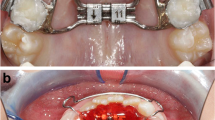Abstract
Subject: The present investigation deals with the questions of whether there is a typical craniofacial morphology in cases with cover-bite malocclusions, whether this type correlates with variation in population, and whether this growth pattern can be influenced by treatment with removable appliances.
Patients and Method: The issue was approached by studying lateral cephalograms of 75 subjects (35 males, 40 females) divided into three groups of 25 subjects each: German cover-bite patients, Syrian cover-bite patients, and subjects with neutroclusion. Overall 125 lateral cephalograms were studied with 13 reference lines and 18 reference angles being taken into account. The data obtained were subjected to statistical analyses using the t-test to detect significant group differences.
Results: The results revealed that there are characteristic features in cover-bite patients in comparison to subjects with neutroclusion and that these features are partly subject to interpopulation differences as well as to interindividual variations. With regard to orthodontic treatment the cover-bite craniofacial morphology is marginally influenceable.
Zusammenfassung
Gegenstand: Die vorliegende Studie befasst sich mit der Fragestellung, ob es für den Deckbiss einen typischen Aufbau des Gesichtsschädels gibt, ob die Morphologie Populationsunterschiede zeigt und ob sie durch herausnehmbare kieferorthopädische Apparaturen beeinflussbar ist.
Patienten und Methodik: Die Untersuchung wurde an seitlichen Fernröntgenaufnahmen des Schädels von 75 Probanden (35 Knaben, 40 Mädchen) durchgeführt, die sich aus drei Gruppen zu je 25 Kindern (deutsche Deckbissträger, syrische Deckbissträger und Probanden mit Regelgebiss) zusammensetzen. Insgesamt wurden 125 Fernröntgenaufnahmen vermessen. Dabei wurden 13 Referenzlinien und 18 Referenzwinkel analysiert. Die gewonnenen Daten wurden mit Hilfe des Computers bearbeitet und mittels t-Test auf signifikante Gruppenunterschiede geprüft.
Ergebnisse: Die Ergebnisse belegen, dass die Deckbissmorphologie im Vergleich zum Regelgebiss charakteristische Merkmale aufweist. Dabei treten individuelle Variationen auf, und die Konfiguration unterscheidet sich von einer Population zur anderen. Der Gesichtsschädelaufbau beim Deckbissträger ist kieferorthopädisch geringfügig beeinflussbar.
Similar content being viewed by others
Author information
Authors and Affiliations
Additional information
Received: September 29, 1997; accepted: December 12, 2000
Rights and permissions
About this article
Cite this article
Youssef, M. Craniofacial Growth Pattern in Cover-Bite Malocclusions and its Therapeutic Influencing. Journal of Orofacial Orthopedics / Fortschritte der Kieferorthopädie 62, 422–435 (2001). https://doi.org/10.1007/s00056-001-9740-6
Issue Date:
DOI: https://doi.org/10.1007/s00056-001-9740-6




